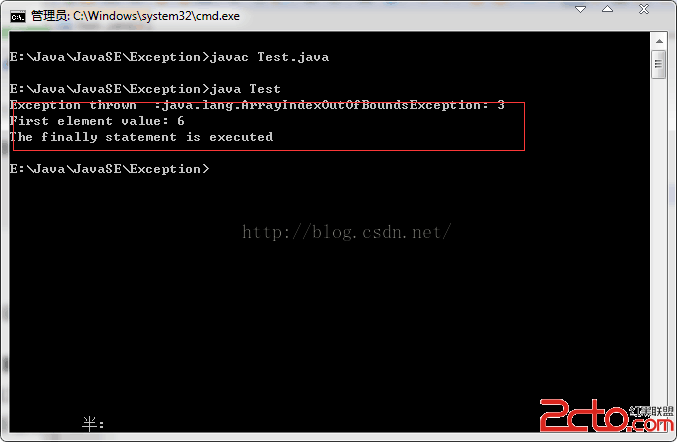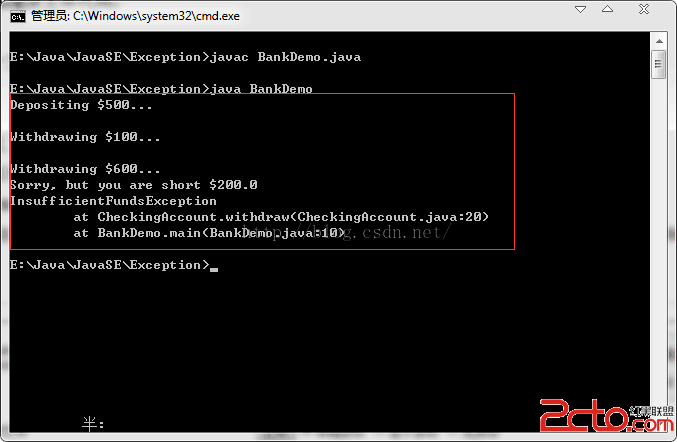如果一個方法沒有捕獲一個檢查性異常,那麼該方法必須使用throws 關鍵字來聲明。throws關鍵字放在方法簽名
的尾部。也可以使用throw關鍵字拋出一個異常,無論它是新實例化的還是剛捕獲到的。throw將產生的異常拋出(動
作);throws——聲明將要拋出何種類型的異常(聲明)。
下面方法的聲明拋出一個RemoteException異常:
import java.io.*;
public class ClassName{
public void deposit(double amount) throws RemoteException{
//Method implementation
throw new RemoteException();
}
//Remainder of class definition
}
一個方法可以聲明拋出多個異常,多個異常之間用逗號隔開。
例如,下面的方法聲明拋出RemoteException和InsufficientFundsException:
import java.io.*;
public class ClassName
{
public void withdraw(double amount) throws RemoteException,InsufficientFundsException
// Method implementation
}
//Remainder of class definition
}
finally關鍵字用來創建在try代碼塊後面執行的代碼塊。無論是否發生異常,finally代碼塊中的代碼總會被執行。在
finally代碼塊中,可以運行清理類型等收尾善後性質的語句。finally代碼塊出現在catch代碼塊最後,語法如下:
try{
// 程序代碼
}catch(異常類型1 異常的變量名1){
// 程序代碼
}catch(異常類型2 異常的變量名2){
// 程序代碼
}finally{
// 程序代碼
}
實例:Test.java源文件代碼:
public class Test{
public static void main(String args[]){
int a[] = new int[2];
try{
System.out.println("Access element three :" + a[3]);
}catch(ArrayIndexOutOfBoundsException e){
System.out.println("Exception thrown :" + e);
}finally{
a[0] = 6;
System.out.println("First element value: " +a[0]);
System.out.println("The finally statement is executed");
}
}
}
以上實例編譯運行結果如下:
 捕獲的異常是數組下標越界。而finally塊中的語句依然執行。
捕獲的異常是數組下標越界。而finally塊中的語句依然執行。
使用注意下面事項:
1)catch不能獨立於try存在。
2)在try/catch後面添加finally塊並非強制性要求的。
3)try代碼後不能既沒catch塊也沒finally塊。
4)try, catch, finally塊之間不能添加任何代碼。
在Java中你可以自定義異常。編寫自己的異常類時需要記住下面的幾點:
1)所有異常都必須是Throwable的子類。
2)如果希望寫一個檢查性異常類,則需要繼承Exception類。
3)如果你想寫一個運行時異常類,那麼需要繼承RuntimeException 類。
使用自定義異常一般步驟如下步驟:
1通過繼承java.lang.Exception類聲明自己的異常類。
2在方法適當的位置生成自定義異常的實例,並用throw語句拋出。
3在方法的聲明部分用throws語句聲明該方法可能拋出的異常。
可以像下面這樣定義自己的異常類:
class MyException extends Exception{
}
只繼承Exception 類來創建的異常類是檢查性異常類。
下面的InsufficientFundsException類是用戶定義的異常類,它繼承自Exception。一個異常類和其它任何類一樣,
包含有變量和方法。
實例:
InsufficientFundsException.java源文件代碼:
import java.io.*;
public class InsufficientFundsException extends Exception{
private double amount;
public InsufficientFundsException(double amount){
this.amount = amount;
}
public double getAmount(){
return amount;
}
}
為了展示如何使用我們自定義的異常類,
在下面的CheckingAccount 類中包含一個withdraw()方法拋出一個InsufficientFundsException異常。
CheckingAccount.java源文件代碼:
import java.io.*;
public class CheckingAccount{
private double balance;
private int number;
public CheckingAccount(int number){
this.number = number;
}
public void deposit(double amount){
balance += amount;
}
public void withdraw(double amount) throws InsufficientFundsException{
if(amount <= balance){
balance -= amount;
}else{
double needs = amount - balance;
throw new InsufficientFundsException(needs);
}
}
public double getBalance(){
return balance;
}
public int getNumber(){
return number;
}
}
下面的BankDemo程序示范了如何調用CheckingAccount類的deposit() 和withdraw()方法。
BankDemo.java源文件代碼:
public class BankDemo{
public static void main(String [] args){
CheckingAccount c = new CheckingAccount(101);
System.out.println("Depositing $500...");
c.deposit(500.00);
try{
System.out.println("\nWithdrawing $100...");
c.withdraw(100.00);
System.out.println("\nWithdrawing $600...");
c.withdraw(600.00);
}catch(InsufficientFundsException e){
System.out.println("Sorry, but you are short $" + e.getAmount());
e.printStackTrace();
}
}
}
編譯上面三個文件(在同一個包內),並運行程序BankDemo,得到結果如下所示:

在Java中定義了兩種類型的異常和錯誤。
JVM(Java虛擬機)異常:由JVM拋出的異常或錯誤。例如:NullPointerException類,
ArrayIndexOutOfBoundsException類,ClassCastException類。
程序級異常:由程序或者API程序拋出的異常。例如IllegalArgumentException類,IllegalStateException類。
1處理運行時異常是,采用邏輯去合理規避同時輔助try-catch處理。
2在多重catch塊後面,可以加一個catch(Exception)來處理可能會被遺漏的異常。
3對於不確定的代碼,也可以加上try-catch,處理潛在的異常。
4盡量取處理異常,切忌只是簡單的調用printStackTrace()去打印輸出。
5具體如何處理異常,要根據不同的業務需求和異常類型去決定。
6盡量添加finally語句塊去釋放占用的資源。